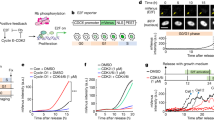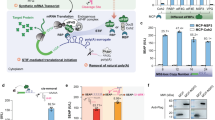Abstract
Serum-stimulation of quiescent mouse fibroblasts results in transcriptional activation of tissue factor (TF), the cellular initiator of blood coagulation. This requires the rapid entry of c-Fos into specific AP-1 DNA-binding complexes and can be strongly inhibited by the adenovirus E1A 12S gene product. In this study, we utilized a panel of E1A mutants deficient in cellular protein binding to analyse the molecular basis for E1A inhibition of a minimal, c-Fos-dependent TF promoter/reporter construct in mouse AKR-2B fibroblasts. Mutations which impaired binding of the retinoblastoma tumor suppressor protein family members pRB, p107, and p130 relieved E1A-mediated inhibition of transcription in response to serum-stimulation or c-Fos overexpression. Inhibition was restricted to the G0 to G1 transition, consistent with the specificity of E1A for hypophosphorylated forms of RB proteins. Although E1A mutants deficient in CBP/p300 binding retained the ability to inhibit TF transcription, deletion of the amino-terminal portion of the CBP/p300 interaction domain was required to permit rescue of TF promoter activity by coexpression of pRB. Moreover, ectopic p107 could effectively substitute for pRB in relieving E1A-mediated repression. In primary mouse embryo fibroblasts, activity of the minimal AP-1-dependent TF promoter was suppressed in Rb−/− cells compared to parallel Rb+/− and Rb+/+ transfectants. Ectopic expression of either pRB or p107 markedly enhanced TF promoter activity in Rb−/− fibroblasts. Collectively, these data imply that pRB and p107 can cooperate with c-Fos to activate TF gene transcription in fibroblasts and suggest a requirement for another, as yet unidentified, E1A-binding protein.
This is a preview of subscription content, access via your institution
Access options
Subscribe to this journal
Receive 50 print issues and online access
$259.00 per year
only $5.18 per issue
Buy this article
- Purchase on SpringerLink
- Instant access to full article PDF
Prices may be subject to local taxes which are calculated during checkout








Similar content being viewed by others
References
Arany Z, Sellers WR, Livingston DM and Eckner R. . 1994 Cell 77: 799–800.
Arias J, Alberts AS, Brindle P, Claret FX, Smeal T, Karin M, Feramisco J and Montminy M. . 1994 Nature 370: 226–229.
Bannister AJ and Kouzarides T. . 1995 EMBO J. 14: 4758–4762.
Barbeau D, Charbonneau R, Whalen SG, Bayley ST and Branton PE. . 1994 Oncogene 9: 359–373.
Bisphopric NH, Zeng G-Q, Sato B and Webster KA. . 1997 J. Biol. Chem. 272: 20584–20594.
Bromberg ME, Konigsberg WH, Madison JF, Pawashe A and Garen A. . 1995 Proc. Natl. Acad. Sci. USA 92: 8205–8209.
Bugge TH, Xiao Q, Kombrinck KW, Flick MJ, Holmbäck K, Danton MJS, Colbert MC, Witte DP, Fujikawa K, Davie EW and Degen JL. . 1996 Proc. Natl. Acad. Sci. USA 93: 6258–6263.
Carmeliet P, Mackman N, Moons L, Luther T, Gressens P, Van Vlaenderen I, Demunck H, Kasper M, Breier G, Evrard P, Müller M, Risau W, Edgington T and Collen D. . 1996 Nature 383: 73–75.
Chen P-L, Riley DJ, Chen Y and Lee W-H. . 1996a Genes Dev. 10: 2794–2804.
Chen P-L, Riley DJ, Chen-Kiang S and Lee W-H. . 1996b Proc. Natl. Acad. Sci. USA 93: 465–469.
Contrino J, Hair G, Kreutzer DL and Rickles FR. . 1996 Nature Med. 2: 209–214.
Dyson N, Buchkovich K, Whyte P and Harlow E. . 1989 Cell 58: 249–255.
Edgington TS, Mackman N, Brand K and Ruf W. . 1991 Thromb. Haemost. 66: 67–79.
Erlich J, Parry GCN, Fearns C, Muller M, Carmeliet P, Luther T and Mackman N. . 1999 Proc. Natl. Acad. Sci. USA 96: 8138–8143.
Felts SJ, Stang MT and Getz MJ. . 1997 Oncogene 14: 1679–1685.
Felts SJ, Stoflet ES, Eggers CT and Getz MJ. . 1995 Biochemistry 34: 12355–12362.
Garriga J, Limon A, Mayol X, Rane SG, Albrecht JH, Reddy EP, Andres V and Grana X. . 1998 Biochem. J. 333: 645–654.
Giannini G, Marcotullio LD, Zazzeroni F, Alesse E, Zani M, T'Ang A, Sorrentino V, Screpanti I, Frati L and Gulino A. . 1997 J. Biol. Chem. 272: 5313–5319.
Gu W, Schneider JW, Condorelli G, Kaushal S, Mahdavi V and Nadal-Ginard B. . 1993 Cell 72: 309–324.
Harlow E, Franza Jr. BR and Schley C. . 1985 J. Virol. 55: 533–546.
Horton RM, Hunt HD, Ho SN, Pullen JK and Pease LR. . 1989 Gene 77: 61–68.
Kiess M, Gill RM and Hamel PA. . 1995 Cell Growth and Differ. 6: 1287–1298.
Kingston RE. . 1999 Nature 399: 199–200.
Kraus VB, Inostroza JA, Yeung K, Reinberg D and Nevins J. . 1994 Proc. Natl. Acad. Sci. USA 91: 6279–6282.
Kwok RPS, Lundblad JR, Chrivia JC, Richards JP, Bächinger HP, Brennan RG, Roberts SGE, Green MR and Goodman RH. . 1994 Nature 370: 223–226.
Lewis BA, Tullis G, Seto E, Horikoshi N, Weinmann R and Shenk T. . 1995 J. Virol. 69: 1628–1636.
Liberati NT, Datto MB, Frederick JP, Shen X, Wong C, Rougier-Chapman EM and Wang X-F. . 1999 Proc. Natl. Acad. Sci. USA 96: 4844–4849.
Lundblad JR, Kwok RPS, Laurance ME, Harter ML and Goodman RH. . 1995 Nature 374: 85–88.
Massagué J, Hata A and Liu F. . 1997 Trends in Cell Biol. 7: 187–192.
Metz R, Bannister AJ, Sutherland JA, Hagemeir C, O'Rourke EC, Cook A, Bravo R and Kouzaride T. . 1994 Mol. Cell. Biol. 14: 6021–6029.
Mueller BM, Reisfeld RA, Edgington TS and Ruf W. . 1992 Proc. Natl. Acad. Sci. USA 89: 11832–11836.
Mulligan G and Jacks T. . 1998 Trends in Genet. 14: 223–229.
Nead MA, Baglia LA, Antinore MJ, Ludlow JW and McCance DJ. . 1998 EMBO J. 17: 2342–2352.
Nevins JR. . 1992 Science 258: 424–429.
Nevins JR, Gustavo L, DeGregori J and Jakoi L. . 1997 J. Cell. Physiol. 173: 233–236.
Nishihara A, Hanai J, Imamura T, Miyazono K and Kawabata M. . 1999 J. Biol. Chem. 274: 28716–28723.
Nishitani J, Nishinaka T, Cheng C-H, Rong W, Yokoyama KK and Chiu R. . 1999 J. Biol. Chem. 274: 5454–5461.
Pietenpol JA, Münger K, Howley PM, Stein RW and Moses HL. . 1991 Proc. Natl. Acad. Sci. USA 88: 10227–10231.
Pietenpol JA, Stein RW, Moran E, Yaciuk P, Schlegel R, Lyons RM, Pittelkow MR, Münger K, Howley PM and Moses HL. . 1990 Cell 61: 777–785.
Prestridge DS. . 1991 Comput. Appl. Biosci. 7: 203–206.
Reddy JC, Hosono S and Licht JD. . 1995 J. Biol. Chem. 270: 29976–29982.
Robbins PD, Horowitz JM and Milligan RC. . 1990 Nature 346: 668–671.
Shao Z, Ruppert S and Robbins PD. . 1995 Proc. Natl. Acad. Sci. USA 92: 3115–3119.
Shen X, Hu PP, Liberati NT, Datto MB, Frederick JP and Wang X-F. . 1998 Mol. Biol. Cell 9: 3309–3319.
Sheppard K-A, Rose DW, Haque ZK, Kurokawa R, McInerney E, Westin S, Thanos D, Rosenfeld MG, Glass CK and Collins T. . 1999 Mol. Cell. Biol. 19: 6367–6378.
Singh P, Coe J and Hong W. . 1995 Nature 374: 562–565.
Smith CL, Onate SA, Tsai M-J and O'Malley BW. . 1996 Proc. Natl. Acad. Sci. USA 93: 8884–8888.
Smith EJ, Leone G and Nevins JR. . 1998 Cell Growth Differ 9: 297–303.
Song C-Z, Loewenstein PM, Toth K and Green M. . 1995 Proc. Natl. Acad. Sci. USA 92: 10330–10333.
Stoflet ES, Schmidt LJ, Elder PK, Korf GM, Foster DN, Strauch AR and Getz MJ. . 1992 Mol. Biol. Cell 3: 1073–1083.
Taylor DA, Kraus VB, Schwartz JJ, Olson EN and Kraus WE. . 1993 Mol. Cell. Biol. 13: 4714–4727.
Tevosian SG, Shin HH, Mendelson KG, Sheppard K-A, Paulson KE and Yee AS. . 1997 Genes Dev. 11: 383–396.
Topper JN, DiChiara MR, Brown JD, Williams AJ, Falb D, Collins T and Gimbrone MA Jr. . 1998 Proc. Natl. Acad. Sci. USA 95: 9506–9511.
Vrana JA, Stang MT, Grande JP and Getz MJ. . 1996 Cancer Res. 56: 5063–5070.
Wang HGH, Draetta G and Moran E. . 1991 Mol. Cell. Biol. 11: 4253–4265.
Wang HGH, Rikitake Y, Corrigan Carter M, Yaciuk P, Abraham SE, Zerler B and Moran E. . 1993 J. Virol. 67: 476–488.
Wang JK, Knudsen ES and Welch PJ. . 1994 Adv. Cancer Res. 64: 25–85.
Acknowledgements
We would like to thank J Nevins, WG Kaelin, Jr, B Dynlacht and H Iba for sharing expression plasmids and T Jacks for providing us with Rb+/+, Rb+/− and Rb−/− mouse embryo fibroblasts. We also thank Sara Felts for helpful discussions and Brenda Birch for assistance in preparing the manuscript. This paper is dedicated in memory of our friend and mentor, Dr Michael John Getz. This work was supported by National Institutes of Health grant CA76083 to MJ Getz and by the Mayo Foundation. S-L, Liu was supported by NIH postdoctoral training grant T32 CA09441.
Author information
Authors and Affiliations
Rights and permissions
About this article
Cite this article
Liu, SL., Rand, A., Kelm, R. et al. The retinoblastoma gene family members pRB and p107 coactivate the AP-1-dependent mouse tissue factor promoter in fibroblasts. Oncogene 19, 3352–3362 (2000). https://doi.org/10.1038/sj.onc.1203675
Received:
Revised:
Accepted:
Published:
Issue date:
DOI: https://doi.org/10.1038/sj.onc.1203675
Keywords
This article is cited by
-
Androgens repress Bcl-2 expression via activation of the retinoblastoma (RB) protein in prostate cancer cells
Oncogene (2004)
-
Regulation of the ER81 transcription factor and its coactivators by mitogen- and stress-activated protein kinase 1 (MSK1)
Oncogene (2003)
-
Regulation of telomerase reverse transcriptase gene activity by upstream stimulatory factor
Oncogene (2003)
-
Synergism between p68 RNA helicase and the transcriptional coactivators CBP and p300
Oncogene (2003)



